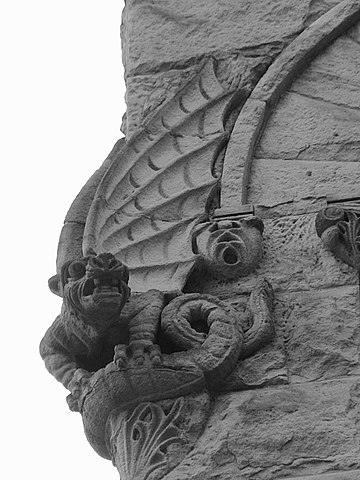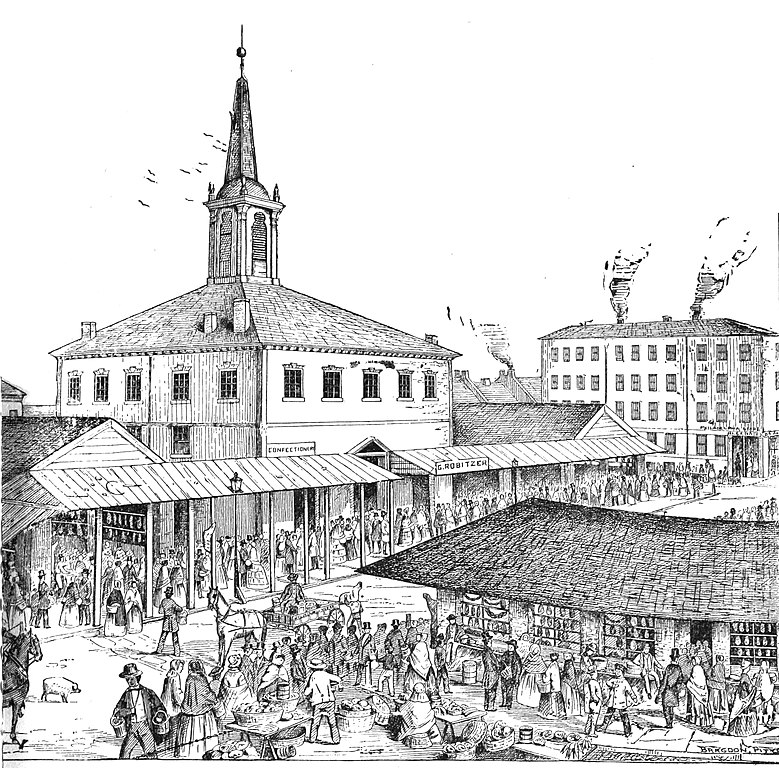
Frederick Osterling designed the small but splendid Marine Bank Building on Smithfield Street at Third Avenue. This gargoyle on the corner is old Pa Pitt’s favorite gargoyle in Pittsburgh.



Forever overshadowed by its taller neighbor the Frick Building, the Allegheny Building, built in 1906, is also by Daniel Burnham, and also a Frick project. It is one of his spare, almost modernistic designs, and it is fascinating to see how well the classical vocabulary adapts to twentieth-century simplicity.

This terra-cotta head of a helmeted allegorical figure (the flowing hair suggests femininity, but the armor suggests “don’t mess with me”) is really a first-rate piece of work, which makes it all the more surprising to find it built into the gable of a rowhouse on the South Side. It is the sort of ornament you add to tell your neighbors, “I am slightly more prosperous than you, because I can afford to have this built into my gable.”
—Old Pa Pitt suspects that this is meant to be a head of Minerva, a Roman goddess you don’t mess with.



The other decorative details on this house are also fine, though more in a vernacular Victorian Romanesque style. This ornament is in the arch above the middle second-floor window.

Old Saint Patrick’s was the first Catholic parish in Pittsburgh, founded in 1808 in what was then the most Presbyterian city in North America. The parish moved more than once, and the current building dates from 1935, after the previous larger building burned.
The parish has a long history, obviously, but it was never more historical than in the 1930s, when the activist labor priest Father Cox broadcast Mass from the church, led marches on Washington, ran for president on the Jobless Party ticket, and got into very public altercations with the fascist radio priest Father Coughlin, who brought an action against him in ecclesiastical court. Father Cox was found guilty of slandering another priest, and Bishop Boyle of Pittsburgh was directed to take appropriate disciplinary action. Bishop Boyle duly noted the verdict, and appears to have decided that the most appropriate disciplinary action was no action at all.
A walled “Theotokos Garden” of statues of saints is a welcome refuge from the bustle of the Strip. Of course the most prominent of the saints is Saint Patrick.


Pittsburgh is a colonial-era city, but downtown has been rebuilt so many times that not much is left from before the Civil War. This building probably dates from the late 1840s, making it one of the oldest remaining downtown. It probably came after the Great Fire of 1845, but it appears in this engraving of the Diamond as it appeared before 1852, which was the year the old courthouse in the middle was torn down.

The building in the background, with smoke rising from its chimneys, is clearly meant to be this one. There are eleven columns of windows in the engraving instead of the nine columns of windows we see today, but old Pa Pitt suspects the engraver was working from a rough sketch and simply gave us his best guess.


This is probably David Gilmour Blythe’s masterpiece, although old Pa Pitt would certainly listen to arguments in favor of The Coal Carrier. It has all the comical details you expect from one of his larger paintings, perfectly executed and worked into an overall composition that is also just about perfect. And yet there is perhaps a whiff of tragedy in the midst of the comedy: this was probably painted during the Civil War (Blythe didn’t date most of his paintings, so we’re just guessing), when you would have seen a crush at the General Delivery window every time the mail came in, because hundreds of people were waiting to hear whether their sons and brothers and husbands were still alive.
The strange power of Blythe is that he paints humanity at its worst, and yet we come away thinking that humanity is worth saving after all.

The Warner was one of the great silent-movie palaces downtown, but it had the misfortune to be placed far from the theater district along Penn Avenue. In the 1980s most of it was demolished for a shopping arcade, leaving the classical façade on Fifth Avenue and the distinctive lighted sign, with the word “Theatre” replaced by “Centre,” because the shopping-arcade and movie-theater industries share an assumption that British spellings attract more customers. The shopping arcade, like most arcades downtown, gradually transitioned to mostly offices. But the sign still dominates the view down Fifth Avenue.


Old Main at Holy Ghost College, now Duquesne University, as it appeared in 1888.
Source: Allegheny County Centennial, a publication from which we’ll be featuring quite a few more pictures.